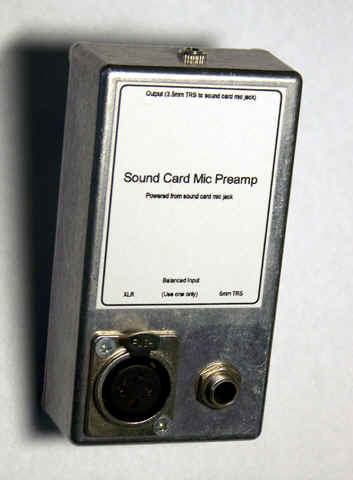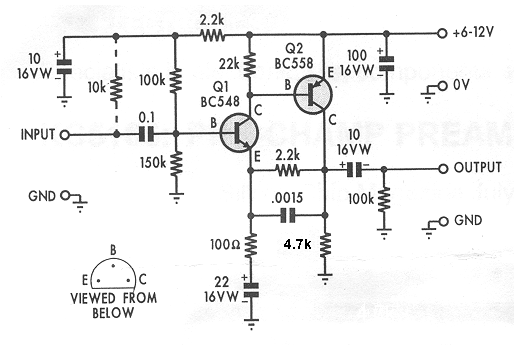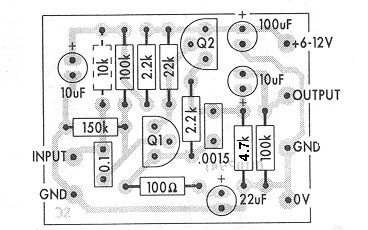Sound card microphone preamplifier
Overview
This article describes a simple preamplifier to enable use of a
dynamic microphone on a computer sound card.
Sound cards commonly have sufficient sensitivity for close speaking
to an electret microphone, but often don't have
sufficient sensitivity for use with a moving coil microphone which
typically has about 20dB less output than common
electrets.
Table 1 tabulates measured and calculated values for a Creative
Vibra 128 sound card under Win2K, and the
dynamic microphone to be used. The microphone output level is 28dB
short of the clipping level with the mic input gain
set to maximum and the optional 20dB internal preamplifier active.
| Item |
Value |
Units |
| Sound card mic input required for full output
at max gain |
0.010 |
Vpp |
| Sound card mic input required for full output
at max gain |
-40.0 |
dBV |
| Microphone sensitivity |
-56.0 |
dBV/Pa |
| Sound pressure level of speech at 300mm (wrt
20uPa) |
74.0 |
dB |
| Speaking distance |
0.120 |
m |
| Sound pressure level of speech at microphone |
82.0 |
dB |
| Microphone output |
-68.0 |
dBV |
| Microphone output |
0.40 |
mV |
| Reserve gain |
10.0 |
dB |
| Required amplifier gain |
38.0 |
dB |
| Cf (use preferred value less than this) |
413 |
pF |
| Rf (use preferred value greater than this) |
7981 |
Ohms |
A spreadsheet that performs the above calculations is available,
click to download the design
spreadsheet.
A ready solution to the problem is the "Pre-Champ Preamplifier"
described in Silicon Chip Magazine July 1994. With
minor modification it will suit, and kitsets including a PCB are
readily available at low price.
The Reserve Gain quantity is included to provide for a small amount
of adjustment using the sound card controls and
an allowance for shortfall of actual gain over the simple prediction
based on the feedback network.
Microphone sensitivity can be obtained from spec sheets or measured.
Dynamic microphones intended for vocal
performance will commonly have values around -55dBV/Pa, a Shure SM58
for example is specified at -54.5dBV/Pa (though
there is usually a fairly wide tolerance... so quoting to a precision
of a tenth of a dB seems questionable). Be
suspicious of sensitivity specs of -75dB, they are probably referenced
to 1 dyne / sq cm or 0.1Pa... add 20dB to
calculate the sensitivity in dBV/Pa.
The amplifier is modified to reduce current so that it can operate
from the DC supply on the ring of the
microphone-in connector of common sound cards. If you sound card does
not supply power in that way, you will need to
obtain a DC supply for the amplifier separately.
Sound cards usually incorporate a power supply for electret FET
amplifiers on the ring of the microphone-in jack,
and the supply is typically +5V through a resistor of several kilohms.
The collector resisistor of Q2 is increased to 4.7K to reduce
current consumption so that the DC supply rail for the
amplifier operates at about 3.5V. Under these conditions, the amplifier
was capable of 500mVpp out before onset of
clipping.
The 2.2K feedback resistor should be changed to provide the design
gain figure. In the case of the design in
Table 1, the required gain called for 7981 value, so 8.2K was
used, being the preferred value that will deliver
the required gain as calculated for Rf in Table 1. Actual gain will be
a little less than predicted using just the two
resistors in the feedback network, especially at high gain levels.
(Excessive gain is undesirable, increases noise,
reduces bandwidth, and increases the risk of clipping in the
sound card mic amp stage. The 10dB reserve gain
allowed provides sufficient additional gain to allow the record gain
setting to be at about 75% of maximum.
The prototype exhibited a signal to noise ratio on recordings of
better than 55dB, 65dB with the mic switch in the
OFF position (which shorts the mic audio out). This is much better than
from a typical PC headset. The frequency
response with 8.2K and 330pF in the feedback network is adequate, lower
3dB point is 78 Hz, and upper 3dB point is
44kHz (well in excess of the upper limit of typical dynamic
microphones). Measured gain was 36dB.
| The AmpChamp preamplifier built in a small die cast box with
input and output jacks. You could build it in a
plastic box, but the diecast aluminium box has shielding advantages.
The output jack is a 3.5mm tip-ring-sleeve (stereo) which is
used for the audio out connection and power supply from
the sound card.
The input jacks are a 6.5mm tip-sleeve (mono) jack and XLR F
jack in parallel.
|

|
| Modified circuit showing the 4.7K resistor in the collector
of Q2.
The 10K bias resistor is only for electret microphones and
should not be used for a dynamic microphone.
Note that the 2.2K feedback resistor between the collector of
Q2 and the emitter of Q1 may need to be changed
depending on the required gain. In my case I used a 8.2K as preferred
value that will deliver at least the required
gain as calculated for Rf in Table 1. Additionally, the 0.0015µF cap in
parallel with Rf should be decreased in
proportion to the increase in Rf to preserve frequency response. I used
330pF.
|

|
| Modified board layout showing the 4.7K resistor in the
collector of Q2.
The feedback components which will need modification to suit
needs are the 2.2K nearest and the 0.0015µF
capacitor that are next to each other between Q1 and Q2.
|

|
| Item |
Jaycar |
Price |
| Amp Champ Pre-amp kit |
KC5166 |
7.95 |
| Aluminium die cast box |
HB5062 |
8.65 |
| 3.5mm stereo jack |
PS0132 |
1.60 |
| 4.7K resistor |
|
|
| 2.7K resistor (or as needed for Rf) |
|
|
| 330pF capacitor (or as needed for Cf) |
|
|
| DC power connector (optional) |
PS0522 |
|
| Miscellaneous hardware, screws, feet etc |
|
|
|
Choose one of more of the following input
connectors
|
| 6.5mm mon jack |
PS0162 |
1.35 |
| XLR 3 pin jack |
PS1024 |
5.00 |
| 3.5mm stereo jack |
PS0132 |
1.60 |
Prices from Jaycar's web site on 12/11/2004. Total parts price is
$20 to $25 depending on the choice of input
connectors.
Common sound card specifications
| Item |
Value |
| Microphone-in |
Sensitivity: 10mV to 200mV RMS
Impedance: 500-600 Ohms
Stereo input jack: TIP Signal RING Bias (if available) SLEEVE Ground |
| Line-in |
Sensitivity: 100mV to 2V RMS
Impedance: 47K-50K Ohms |
| Line-out |
0 to 2V RMS
Impedance: assumed 10K Ohms, some cards 600 Ohms |
Be aware that the microphone input to a sound card is usually mono.
Do not be mislead by the tip-ring-sleeve jack,
the ring is used for a DC supply for the electret amplifier.
Changes
| Version |
Date |
Description |
| 1.01 |
11/11/2004 |
Initial release. |
| 1.02 |
13/11/2004 |
Added information on frequency response. |
| 1.03 |
15/11/2004 |
Added details of gain / frequency response. Design
spreadsheet updated to calculate Cf. |
| 1.04 |
16/11/2004 |
Added words re DC supply from ring of mic-in connector. |
© Copyright:
Owen Duffy 1995, 2021. All rights reserved. Disclaimer.


